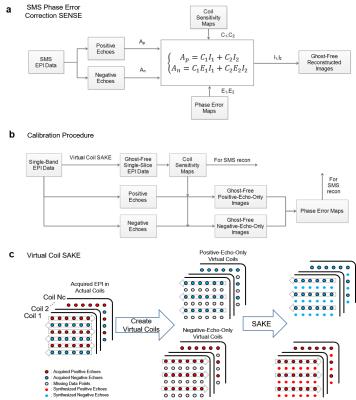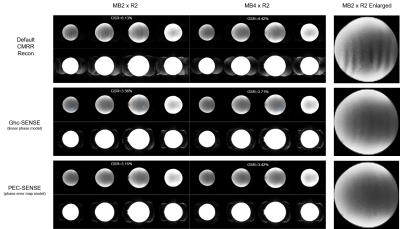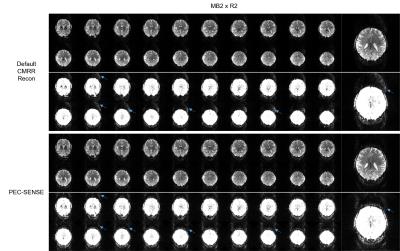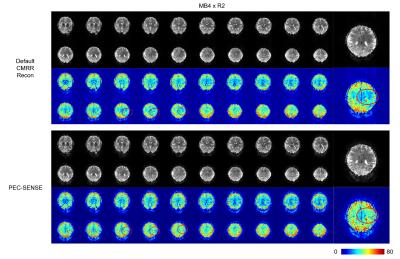0515
Robust 2D Nyquist Ghost Correction for Simultaneous Multislice (SMS) EPI Using Phase Error Correction SENSE and Virtual Coil SAKE1Laboratory of Biomedical Imaging and Signal Processing, The University of Hong Kong, Hong Kong SAR, People's Republic of China, 2Department of Electrical and Electronic Engineering, The University of Hong Kong, Hong Kong SAR, People's Republic of China, 3Centre for Advanced Imaging, University of Queensland, Brisbane, Australia, 4Toshiba Medical Systems (China), Beijing, People's Republic of China, 5School of Biomedical Engineering, Southern Medical University, Guangzhou, People's Republic of China
Synopsis
Nyquist ghost is problematic in SMS EPI because the ghost is slice-dependent and can interfere with slice separation process. The inconsistency between positive and negative echoes can be represented by 2D phase error maps. This study presents a new and robust SENSE-based method. It estimates both phase error maps and coil sensitivities from one plain EPI based calibration scan, and then uses these maps for ghost-free SMS EPI reconstruction. Further, to improve coil sensitivity estimation, virtual coil SAKE is incorporated to reduce the high order Nyquist ghost in the calibration scan.
Introduction
Nyquist ghost artifact in EPI, can be traced to the inconsistency between echoes acquired during opposite readout gradients. With SMS acceleration, Nyquist ghost becomes more problematic because the ghost is slice-dependent and can interfere with slice separation process [1,2,3]. Nyquist ghost in SMS EPI can be corrected using SENSE with 1D linear phase error model (Ghc-SENSE) [2,3]. However, such simple model cannot remove the high order phase error associated with poor eddy current condition and field inhomogeneity. More advanced solutions [4,5] such as dual-polarity GRAPPA [5] can handle such high order phase error, but usually need several temporally-encoded calibration scans, which require sequence modification, and may be sensitive to motion due to prolonged scan time [6]. On the other hand, the inconsistency among echoes can be represented by 2D phase error maps [7,8,9]. This study presents a new SENSE-based method. It estimates both phase error maps and coil sensitivities from one plain EPI based calibration scan, and then uses these maps for SMS reconstruction. Further, to improve coil sensitivity estimation, virtual coil SAKE [10] is incorporated to reduce the high order Nyquist ghost in the calibration scan.Methods
SMS Reconstruction Procedure (Fig. 1a): Phase error maps can be regarded as generalized coil sensitivity maps [7,8,9]. Thus, the negative echoes can be considered as from virtual coils whose sensitivity maps are multiplied by the (relative) phase error maps, while positive echoes are encoded by normal sensitivity maps [2,8,9]. Once coil sensitivity maps and slice-wise phase error maps are determined, SMS data can be reconstructed using phase error correction (PEC) SENSE [9]. Calibration Procedure (Fig. 1b): To match geometry distortion, a multi-shot EPI scan (shot number equals to the in-plane acceleration factor for SMS data) is used for coil sensitivity maps [2]. In fact, such EPI-based calibration scan also contains the same phase error as in the SMS EPI data. After obtaining coil sensitivities, phase error maps can be extracted by comparing the phase images separately reconstructed from positive and negative echoes [9]. Virtual Coil SAKE (Fig. 1c): One problem still remains: the EPI-based calibration scan may contain high order phase error, which cannot be removed by linear phase error correction and may degrade coil sensitivity estimation. Here, we propose virtual coil (VC) SAKE, which performs low-rank reconstruction on the aforementioned virtual coils to remove the remaining high order ghost. Experiments: Phantom and brain SMS EPI data were acquired on a 7T whole-body research scanner (Siemens Healthcare) using the CMRR sequence [11] and a 32-channel head coil (Nova Medical) at MB2×R2 and MB4×R2 (MB for multiband factor, R for in-plane acceleration factor). A 2-shot EPI scan was acquired for calibration of coil sensitivity and phase error maps.Results
High order ghost in the EPI calibration scan could compromise coil sensitivity estimation (Fig. 2). Virtual coil SAKE effectively removed those residual ghosts, leading to improved coil sensitivity estimation. Phantom results (Fig. 3) shows that, the proposed method robustly resulted in less Nyquist ghost than Ghc-SENSE and the default CMRR reconstruction. Similar results were obtained from the brain data (Fig. 4) where PEC-SENSE led to lesser ghost than default CMRR reconstruction. Ghc-SENSE result was similar to PEC-SENSE for this data set and therefore not shown. PEC-SENSE was successfully applied to MB4×R2 (Fig. 5), with temporal SNR similar to or slightly higher than that the default CMRR reconstruction.Discussion and Conclusions
PEC-SENSE with VC-SAKE can robustly correct the slice-dependent Nyquist ghost artifact in SMS EPI, leading to lesser artifact than 1D linear phase correction. Moreover, it offers good SNR performance and can be applied to highly accelerated data. Phase error maps will not significantly alter the conditioning of general SENSE system, bringing no extra SNR loss as long as phase error maps are accurate [2]. In our method, the phase error map is obtained through reconstructing R×2 in-plane accelerated calibration data sets. Since the coil is capable of MB×R acceleration, we expect to correctly reconstruct the R×2 data sets with reasonable SNR. In this regard, the phase error map estimation is reliable. Another novel aspect of our method is that all calibration only requires one plain multi-shot EPI scan instead of several temporal-encoded scans, thus our method mitigates the risk that motion occurs during the calibration stage. Such calibration strategy may also benefit GRAPPA-based method. As a low-rank based method [12, 13], virtual coil SAKE method is similar to ALOHA [12], but with much simpler implementation. Such low-rank data recovery explores the redundancy between the negative and positive echoes while the phase error information is preserved in virtual coils.Acknowledgements
No acknowledgement found.References
[1] Barth M, et.al., Magn Reson Med 2016;75(1):63-81.
[2] Hennel F, et. al., Magn Reson Med 2016;76(3):873-879.
[3] Zhu K, et. al., ISMRM 2014. No. 647.
[4] Koopmans PJ, et. al., Magn Reson Med. 2016.
[5] Hoge WS, et. al., ISMRM 2016. No. 3245.
[6] Talagala SL, et. al., Magn Reson Med 2016;75(6):2362–2371.
[7] Chen NK, et. al., Magn Reson Med 2004;51(6):1247-1253.
[8] Xu D, et. al., Magn Reson Med 2010;64(6):1800-1813.
[9] Xie VB, et. al, ISMRM 2016, No. 50.
[10] Shin PJ, et. al., Magn Reson Med 2014; 72(4):959-70.
[11] https://www.cmrr.umn.edu/multiband/
[12] Lee J, et. al., Magn Reson Med 2016.
[13] Kim TH, et. al., Magn Reson Med 2016.
Figures




